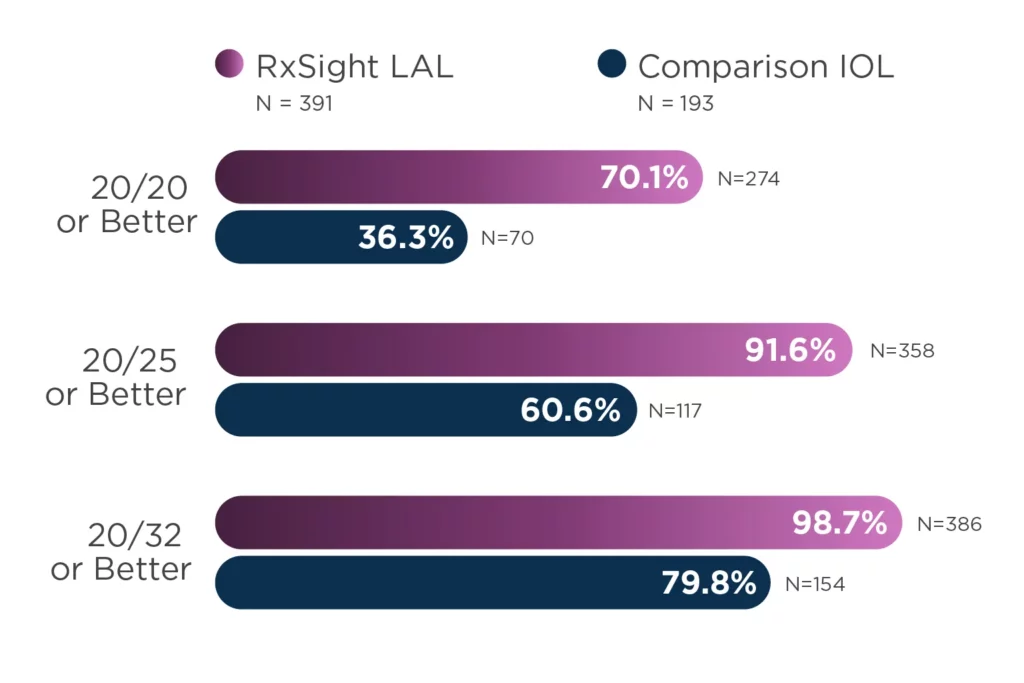Approved use: The Light Adjustable Lens™ (LAL®), Light Adjustable Lens+™ (LAL+™), and Light Delivery Device™ (LDD™) system is approved for patients who have a cataract and need surgery for it, have corneal astigmatism (at least 0.75 diopters) before surgery, and do not have preexisting macular disease.
Who should not receive this treatment? The LAL/LAL+ and LDD system should not be used if you are taking medications that may increase your sensitivity to ultraviolet (UV) light; if you are taking a medication that is considered harmful to your retina; if you have a history of herpes eye infection or uncontrollable eye movements (nystagmus); or if you are unable to comply with your doctor’s schedule of LDD light treatments and instructions for wearing special UV-protective glasses for several weeks following cataract surgery.
What warnings should I be aware of? Preexisting macular disease and certain eye conditions may increase the risk of complications. Your doctor will determine if you are a good candidate for the LAL/LAL+. If you have any complications during your cataract surgery before the LAL/LAL+ is implanted, you may need to have another intraocular lens (IOL) implanted instead of the LAL/LAL+.
What precautions should I be aware of? The safety and effectiveness of the LAL and LDD have not been established in patients with certain preexisting eye conditions or in patients who experience certain complications during cataract surgery. The safety and effectiveness of the LAL+ has not been substantiated in clinical trials. The effect of the LAL+ optical design on quality of vision, contrast sensitivity, and subjective visual disturbances have not been evaluated clinically. You should discuss these issues with your doctor.
Following surgery, you must wear the special UV-protective glasses during all waking hours for about 4 to 5 weeks and comply with your doctor’s schedule of LDD light treatments. Failure to wear the UV-protective glasses can result in an unpredicted vision change or loss of vision quality after exposure to UV light, such as from sunlight. This may require a second surgery to remove the LAL/LAL+ from your eye and replace it with another IOL.
What are the potential risks? As with any surgical procedure, there are risks associated with cataract surgery and IOL implantation. Please discuss these risks with your doctor. Potential risks associated with LDD light treatments include mild alterations to color perceptions; temporary scratchiness, irritation, or dryness to the front part of your eye; and activation of a previously undiagnosed herpes eye infection. Longer lasting and serious adverse events related to the UV light exposure are possible, but rare. There is a small chance that your vision could be made worse or that you may require additional surgery as a result of a complication.
Caution: Federal law restricts this device to sale by or on the order of a physician.
©2024 RxSIGHT. All Rights Reserved. COM-1167 Rev. A

The LAL provides optimized vision for patient satisfaction.2
LAL patients saw nearly as well without glasses (UCDVA) as control patients did with glasses (BCDVA).
Since the LAL is a monofocal lens, there is low risk of dysphotopsias caused by splitting light, leading to potentially enhanced vision and patient satisfaction.

The LAL offers LASIK-like accuracy in cataract surgery.2,3
92% of eyes (N = 391) achieved results within 0.50 D of target manifest refraction spherical equivalent (MRSE).
Patients are approximately two times more likely to achieve 20/20 vision or better without glasses at 6 months.
The study was a prospective, controlled, multicenter, 12-month study of 600 patients (ITT population) randomized to receive implantation with the RxSight LAL (N = 403) or a commercially available monofocal IOL (N = 197). Effectiveness analyses included 391 LAL patients and 193 control patients. Primary safety variables included best spectacle-corrected visual acuity (BSCVA) at 6 months and incidence of sight-threatening complications and adverse events. Primary effectiveness variables included percent reduction in manifest cylinder at 6 months, percent mean absolute reduction in MRSE at 6 months, and rotation of meridian of LAL at 6 months. Percent of eyes with an uncorrected visual acuity (UCVA) of 20/20 or better at six months post-operatively compared between the LAL treatment group and the monofocal control group was a secondary endpoint.

The Light Adjustable Lens corrects down to 0.5 diopters of astigmatism, which is the lowest level approved to be treated.